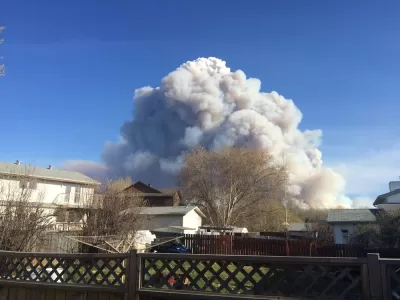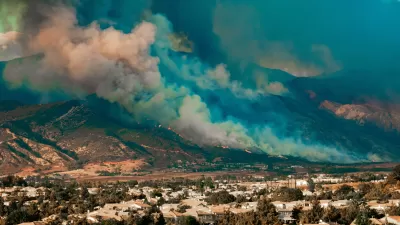Wildfires tend to start at the Wildland-Urban Interface: those border zones between cities and the open land surrounding them. Keeping the lid on sprawl, it can be argued, would tame the inferno.

As another summer of wildfires blazes on, it's hard not to notice the types of neighborhoods they regularly threaten. Adam Rogers writes, "The key to how we think about fire's severity [...] is not the number of fires, or even their magnitude, but where they are—and what's near them."
In fire-prone states like California, Texas, and Colorado, suburban sprawl often occupies the Wildland-Urban Interface (WUI) where wildfires often start. "Humans set most wildfires—95 percent of them, according to CalFire. That's a real problem when, as of 2004 in the continental US, the WUI was almost 278,000 square miles and contained 44.8 million housing units."
In a sense, the urban housing crisis exacerbates our risk from fire, and those affected are those priced out. "At a time when cities all over the country are experiencing housing crises, unable or unwilling to build enough units to accommodate growing populations, the greatest expansion of houses is on previously unbuilt spaces at the edges of cities."
FULL STORY: The West Is on Fire. Blame the Housing Crisis

Study: Maui’s Plan to Convert Vacation Rentals to Long-Term Housing Could Cause Nearly $1 Billion Economic Loss
The plan would reduce visitor accommodation by 25,% resulting in 1,900 jobs lost.

North Texas Transit Leaders Tout Benefits of TOD for Growing Region
At a summit focused on transit-oriented development, policymakers discussed how North Texas’ expanded light rail system can serve as a tool for economic growth.

Why Should We Subsidize Public Transportation?
Many public transit agencies face financial stress due to rising costs, declining fare revenue, and declining subsidies. Transit advocates must provide a strong business case for increasing public transit funding.

How to Make US Trains Faster
Changes to boarding platforms and a switch to electric trains could improve U.S. passenger rail service without the added cost of high-speed rail.

Columbia’s Revitalized ‘Loop’ Is a Hub for Local Entrepreneurs
A focus on small businesses is helping a commercial corridor in Columbia, Missouri thrive.

Invasive Insect Threatens Minnesota’s Ash Forests
The Emerald Ash Borer is a rapidly spreading invasive pest threatening Minnesota’s ash trees, and homeowners are encouraged to plant diverse replacement species, avoid moving ash firewood, and monitor for signs of infestation.
Urban Design for Planners 1: Software Tools
This six-course series explores essential urban design concepts using open source software and equips planners with the tools they need to participate fully in the urban design process.
Planning for Universal Design
Learn the tools for implementing Universal Design in planning regulations.
City of Santa Clarita
Ascent Environmental
Institute for Housing and Urban Development Studies (IHS)
City of Grandview
Harvard GSD Executive Education
Toledo-Lucas County Plan Commissions
Salt Lake City
NYU Wagner Graduate School of Public Service





























